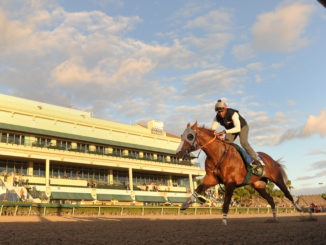
After the events of the past week, it would not be wrong to suggest that among the most resilient things in American racing today is the Preakness (G1). Back in its rightful spot this year on the third Saturday in May, the Preakness and its organizers had to deal with a whole host of challenges.
No Preakness, of course, can avoid the ritual media drum bang about the deteriorating condition of Pimlico’s physical plant. However, that proved the least of the challenges with on-track attendance capped at 10,000 anyway due to pandemic restrictions.
More troubling, at first, was the field’s composition. Despite the fact four horses finished within a length of each other at the end of the Kentucky Derby (G1) two weeks earlier, only the first-placed Medina Spirit was ever confirmed for the Preakness. Of the 20 Kentucky Derby starters, only three bothered to turn up in Baltimore.
Not surprisingly, this development provided an opening for an old idea to be resurrected in certain quarters — that Pimlico, for its own benefit and that of the sport, needs to capitulate to modern horsemanship and training methods by finding a date for the Preakness that would be more hospitable to those who would surely jump at the chance to compete in both races if not for the quick two-week turnaround.
A field of 10, including seven “new shooters,” was eventually rounded up for the Preakness. That’s not a great number, and ordinarily one would have expected Medina Spirit to have been close to an odds-on favorite in that scenario, given his closest Derby pursuers were absent and the relatively limited appeal of the Triple Crown newcomers. This observer, in less-than-kind words, privately intimated to those within earshot beforehand that it was the least-distinguished Preakness he could recall.
Of course, the biggest challenge Preakness organizers faced was the black cloud hanging over race favorite Medina Spirit, the details of which are well known and need not be rehashed here. The adage that there’s no such thing as bad publicity doesn’t always hold water when it comes to Thoroughbred racing, rightfully so in many cases.
From a relatively small crowd and race field, to a marquee horse in the main event that entered with a stain, the 2021 Preakness had every right to turn out disappointing. In fact, the opposite happened.
Shockingly, this Preakness turned out to be the most popular, wagering-wise, in race history. Betting on the Preakness itself was up nearly 11% over the 2019 edition, the last time it was held on its traditional date, and it also crushed the all-time record set in 2005. Total wagering on the Preakness card was more than $113 million, the first time it had handled more than $100 million. Friday’s Black-Eyed Susan card also produced record handle of more than $27 million.
What accounts for this unexpected success? For starters, the weather over the weekend was absolutely ideal and much improved over Preakness weekend conditions dating back to the middle of the last decade. While the undercard stakes lacked much in the way of star power and the supporting allowances were won by short-priced horses, field size was reasonably strong. It also might have helped that some tracks that have normally raced on Preakness Day did not for various reasons.
The Preakness itself turned out to be a more attractive betting race than one might have expected, with Medina Spirit a lukewarm 2-1 favorite and many of the new shooters inexplicably taking more action than they seemingly deserved. Although the finish to the Preakness itself didn’t turn out as spine-tingling as the Derby, it was a much more truly run race, with an honest, contested pace and the opportunity for closers to make an impact late if they were good enough.
The Preakness also resulted in a story racing fans can feel good about. Owners John and Diane Fradkin operate a relatively small commercial breeding enterprise and now have reached one of the sport’s pinnacles. A humble and emotional trainer Michael McCarthy was overcome with pride and joy after seeing his first classic starter win, and jockey Flavien Prat now knows how it feels to win a Triple Crown race by crossing the finish line in first.
Everything but the kitchen sink was thrown at the Preakness this year and, once again, it proved resilient in the face of it all. The handle figures alone suggest that it’s nowhere close to the commercially unattractive dumpster its critics imagine it to be in, despite the lack of support of some horsemen with good three-year-olds. It remains, as it always has in the era of full-card simulcasting and online wagering, one of the four biggest betting days in American racing alongside the Kentucky Derby, Belmont Stakes, and Breeders’ Cup Saturday.
Having addressed this issue in a piece back in 2016, the bottom line is that while Pimlico may be broken (but not for many years longer), the Preakness is not. Moving the race away from its current position on the calendar would seemingly put its popularity with the betting and viewing public at risk. Nor would it necessarily receive cooperation from the folks at the New York Racing Association, who’ve done so well at enhancing and maintaining Belmont Day as a top-four betting attraction on an annual basis. They presumably like their traditional early June spot as is, and it obviously works for them.
Handcuffed by their current practices, stubborn horsemen might continue to pass on the Preakness with otherwise capable Kentucky Derby starters. As the results of the weekend suggest, that’s a problem in search of a fix more than the Preakness’ long-held position on the third Saturday in May.



